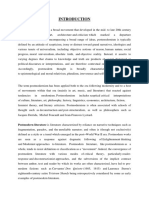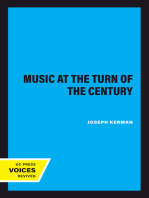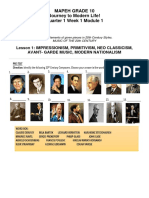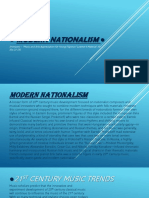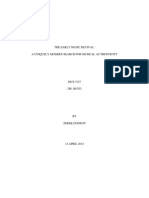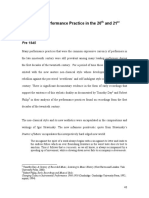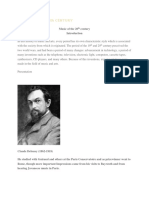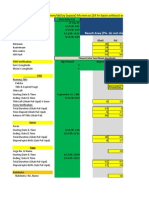The Concept of Post Modernism
The Concept of Post Modernism
Uploaded by
Eric TanCopyright:
Available Formats
The Concept of Post Modernism
The Concept of Post Modernism
Uploaded by
Eric TanOriginal Description:
Copyright
Available Formats
Share this document
Did you find this document useful?
Is this content inappropriate?
Copyright:
Available Formats
The Concept of Post Modernism
The Concept of Post Modernism
Uploaded by
Eric TanCopyright:
Available Formats
THE CONCEPT OF POST-MODERNISM
The Concept of Post-Modernism
Eric Tan Boon Kiat
Universiti Malaya
REA130012
19th May 2014
THE CONCEPT OF POST-MODERNISM
Abstract
This essay is about the concept or idea post-modernism or post-modern styles and examples of
composers who practices post-modern styles. This essay also describes a brief summary of the
early and late twentieth century.
THE CONCEPT OF POST-MODERNISM
The Concept of Post-Modernism
The first half of the twentieth century experienced a progressive breakup of the tonal
harmonic system that had triumphed for the preceding two hundred years. Schoenberg, at first
instinctively and later methodically with his twelve tone method, introduced a radically new
conception of musical form and, with his emancipation of the dissonance, in effect ended the
traditional difference between consonance and dissonance. As the century moved on,
Schoenbergs method was used to all elements of musical composition before combined with
other, freer methods of composition. Traditional concepts about musical sound and even about
the art of composition itself were also transformed in the twentieth century. For example, there
were introduction of new timbres and musical instruments, expansion of the pitch continuum and
experimentation with spatial effects, usage of various electronic media and technologies, and the
idea of indeterminacy in musical compositions. In consequence, different and unique modes of
interaction adjusted the customary roles of composer and performer. Affected by their own
cultural, political, and geographic realities, European composers have adapted musical styles that
are distinct and separate from those of their American counterparts. Yet, by the late twentieth
century, some Europeans had integrated into new styles and trends. One of those trends is postmodern styles or post-modernism.
A number of architects, such as Robert Venturi, Philip Johnson, and Cesar Pelli, turned
away from the faceless glass facades of the middle twentieth century by putting together
elements of earlier styles into modern designs. This combination is known as post-modern.i
THE CONCEPT OF POST-MODERNISM
The main aspect of post-modernism is a turning away from the belief, crucial to
modernist thought, that history progresses irreversibly in one direction. Musically, this concept
means leaving the notion that musical idioms develop continuously, as if according to a plan or
some inner need. The theory of post-modernism is that history gives the performer or composer
more freedom than that; the styles of all epochs and cultures are equally accessible as a material,
to be used as the composer sees fit.
A composer who quoted from and used past styles with optimum capacity was Alfred
Schnittke(1934-1998). He worked in Soviet Union, where was known mainly for his film music,
before moving to Germany in 1990. When the Soviet Government began to relax its control over
culture, Shnittke and other young composers were exposed to Western trends such as serials,
chance, and electronic music. After composing several pieces based on serialism, indeterminacy,
and new instrumental sounds, Schnittke used the method called polystylism, which is a mixture
of new and older styles composed through quotation or stylistic allusion. Schnittkes Symphony
No.1 consists of passages from works by Haydn, Beethoven, Chopin, Tchaikovsky, Grieg,
Johann Strauss, and Schnittke himself. His music displays a contrast not only of styles but of
historical periods.ii
Besides Schnittke, George Rochberg (b. 1918), who had once relied on serial methods,
built a quilt from the works of Mozart, Beethoven, Mahler, Webern, Varese, Stockhausen, and
past composed works of his own in Music for a Magic Theater( 1965). In addition, he
cultivated the style of a Baroque toccata and quoted short passages from J.S. Bachs Partita No.
6 for keyboard. Like Bach, Rochberg starts off with an arpeggios followed by a typical double-
THE CONCEPT OF POST-MODERNISM
dotted effect and a descending appoggiatura. But Bachs arpeggios contain only the notes of the
E-minor triad whereas Rochbergs contains all twelve notes of the chromatic scale. Equivalently,
that arpeggio that resolves the appoggiatura includes all of the notes of Bachs chord but in
adding in Bb, Eb, and B. iii
One of the most astounding re-creations of an earlier musical world is David Del Tredicis In
Memory of a Summer Day (Child Alice, Part One, 1980). Del Tredici (b. 1937) translated
Wagners Liebestod into modern-but not so modern-terms without taking any of Wagners
motives, just his manner of developing them, his harmony, and his superb orchestration. The
similarity of the theme to the kiss motive in Verdis Otello may be accidental. The purpose
of the backward look seems in this case to be communication instead of parody or irony. iv
In my personal opinion, post-modern styles are actually acceptable and are worthy to be
adapted. I sincerely believe that music is free and composers are allowed to use any material
from the past or with present technologies. I personally feel that composers ought to be more
creative and to think out of the box especially in our time.
THE CONCEPT OF POST-MODERNISM
i Barbara Russano Hanning. (2002). Concise History of Western Music. (Second
Edition). pp 539, 575.
ii J. Peter Burkholder, Donald Jay Grout, Claude V. Palisca. (2006). A History of
Western Music. (Seventh Edition). pp 958-959.
iii Donald Jay Grout, Claude V. Palisca. (2001). A History of Western Music. (Sixth
Edition). pp 782.
iv
Barbara Russano Hanning. (1998). Concise History of Western Music. pp. 550.
THE CONCEPT OF POST MODERNISM
Bibliography
Barbara Russano Hanning. (2002). Concise History of Western Music. (Second
Edition).
New York, London. W.W. Norton & Company.
J. Peter Burkholder, Donald Jay Grout, Claude V. Palisca. (2006). A History of
Western Music.
(Seventh Edition).
New York, London. W.W. Norton & Company.
Donald Jay Grout, Claude V. Palisca. (2001). A History of Western Music. (Sixth
Edition)
New York, London. W.W. Norton & Company.
Barbara Russano Hanning. (1998). Concise History of Western Music.
New York, London. W.W. Norton & Company.
You might also like
- (Joseph Nathan Straus) Remaking The Past Musical (B-Ok - Xyz)Document225 pages(Joseph Nathan Straus) Remaking The Past Musical (B-Ok - Xyz)Valerio Sebastiani100% (1)
- Luciano Berio Sinfonia 1968 9Document33 pagesLuciano Berio Sinfonia 1968 9Andrea Bagnolo100% (2)
- Modernism & Post Modernism ArchitectureDocument46 pagesModernism & Post Modernism Architecturedaniel desalgn100% (1)
- Post ModernismDocument44 pagesPost ModernismSreerag NandakumarNo ratings yet
- Psychoanalytic CriticismDocument2 pagesPsychoanalytic CriticismTimothy CraigNo ratings yet
- ExpressionismDocument13 pagesExpressionismAndrei Raicu100% (1)
- Post ModernismDocument34 pagesPost ModernismThinang Jamatia100% (1)
- Romanticism: By: Leila WalkerDocument29 pagesRomanticism: By: Leila WalkerMax HeineggNo ratings yet
- Undressing The Ad: Reading Culture in AdvertisingDocument17 pagesUndressing The Ad: Reading Culture in AdvertisingHindol NandyNo ratings yet
- PostmodernismDocument9 pagesPostmodernismMalkish Rajkumar100% (1)
- RomanticismDocument25 pagesRomanticismJason Tiongco100% (1)
- Modernism and Post ModernismDocument7 pagesModernism and Post ModernismJames JohnsonNo ratings yet
- Modern and Contemporary MusicDocument10 pagesModern and Contemporary MusicScribdTranslationsNo ratings yet
- 20th-Century Classical Music - Wikipedia PDFDocument59 pages20th-Century Classical Music - Wikipedia PDFJerma Lyn BruaNo ratings yet
- 20th Century MusicDocument5 pages20th Century MusicDavid100% (1)
- Mapeh Grade 10 Module 1Document12 pagesMapeh Grade 10 Module 1Jorely Barbero Munda82% (11)
- Postmodern Music - Postmodern Thought - ExcerptDocument14 pagesPostmodern Music - Postmodern Thought - ExcerptParker CallisterNo ratings yet
- Modernism and ImprovisationDocument3 pagesModernism and ImprovisationGary Martin RolinsonNo ratings yet
- Modern Nationalism 2019 Version PresentationDocument8 pagesModern Nationalism 2019 Version PresentationTon OpridoNo ratings yet
- Modern ComposersDocument103 pagesModern ComposersctanksleyNo ratings yet
- Poliestilismo SchnittckeDocument4 pagesPoliestilismo SchnittckeVaya TelaNo ratings yet
- Elizabeth Makharinsky Dec 12/jan 13 Exeter CollegeDocument7 pagesElizabeth Makharinsky Dec 12/jan 13 Exeter CollegemakharinskyNo ratings yet
- Styles of The Modern EraDocument4 pagesStyles of The Modern EraCarlos del Río SilvánNo ratings yet
- Muzik Zaman BarokDocument19 pagesMuzik Zaman BarokRidzuan IdangNo ratings yet
- Pointers To Review For The Quarter 1 MAPEH 10Document51 pagesPointers To Review For The Quarter 1 MAPEH 10Gian ObongenNo ratings yet
- 2620-Article Text-6987-1-10-20170212Document10 pages2620-Article Text-6987-1-10-20170212Erhan SavasNo ratings yet
- Ornamentation Baroque ClassicDocument30 pagesOrnamentation Baroque ClassicMarcelo Cazarotto Brombilla100% (5)
- The Early Music Revival: A Uniquely Modern Search For Musical AuthenticityDocument12 pagesThe Early Music Revival: A Uniquely Modern Search For Musical AuthenticitytomzerekNo ratings yet
- Paulo C. Chagas - Unsayable Music - Six Reflections On Musical Semiotics, Electroacoustic and Digital Music-Leuven University Press (2014)Document279 pagesPaulo C. Chagas - Unsayable Music - Six Reflections On Musical Semiotics, Electroacoustic and Digital Music-Leuven University Press (2014)garuttimiguelNo ratings yet
- On Serial CompositionDocument22 pagesOn Serial CompositionOmar Hernandez Lazo100% (1)
- The Early Music Revival: A Uniquely Modern Search For Musical AuthenticityDocument12 pagesThe Early Music Revival: A Uniquely Modern Search For Musical AuthenticitytomzerekNo ratings yet
- MusicalModernism AbstractsDocument15 pagesMusicalModernism Abstractsciprian_tutuNo ratings yet
- Primitvism: BELA BARTOK (1881-1945)Document6 pagesPrimitvism: BELA BARTOK (1881-1945)zach catindigNo ratings yet
- Vocal and Instrumental Music of 20th CenturyDocument3 pagesVocal and Instrumental Music of 20th CenturyJasmine Mae LapigNo ratings yet
- Impressionism in MusicDocument3 pagesImpressionism in MusicDiana GhiusNo ratings yet
- Chapter 3 - Performance Practice in The 20 and 21 CenturiesDocument39 pagesChapter 3 - Performance Practice in The 20 and 21 CenturiesErduandNo ratings yet
- BLACKBURN Music Theory and Musical Thinking After 1450 PDFDocument46 pagesBLACKBURN Music Theory and Musical Thinking After 1450 PDFDomen Marincic100% (3)
- (Eastman Studies in Music) James M. Baker, David Beach, Jonathan W. Bernard - Music Theory in Concept and Practice - University of Rochester Press (1997)Document903 pages(Eastman Studies in Music) James M. Baker, David Beach, Jonathan W. Bernard - Music Theory in Concept and Practice - University of Rochester Press (1997)risaldisyaputra03No ratings yet
- Billan Liao - Persuasive Speech - ScriptDocument4 pagesBillan Liao - Persuasive Speech - ScriptBillan LiaoNo ratings yet
- Music 10 2015Document25 pagesMusic 10 2015Jeric MatunhayNo ratings yet
- Introduction To Microtonal MusicDocument34 pagesIntroduction To Microtonal Musicfelipe locksNo ratings yet
- History of Western Philosophy of Music - Since 1800Document26 pagesHistory of Western Philosophy of Music - Since 1800IphiNo ratings yet
- 11 Alper Making Sense Out of Postmodern MusicDocument15 pages11 Alper Making Sense Out of Postmodern MusicWilfredo SuarezNo ratings yet
- Blackburn-Music Theory and Musical Thinking AfterDocument46 pagesBlackburn-Music Theory and Musical Thinking Afterrrmm68No ratings yet
- Music of The 20th CenturyDocument8 pagesMusic of The 20th CenturyAlbert Ian CasugaNo ratings yet
- N To The Fact That This Description Focuses On Compositional Techniques and Very Little Is Said About Dominant GenresDocument19 pagesN To The Fact That This Description Focuses On Compositional Techniques and Very Little Is Said About Dominant GenresAntonette Zamora- NuevaNo ratings yet
- Elliot Carter Expressionism and American MusicDocument14 pagesElliot Carter Expressionism and American MusicJon Gillin100% (1)
- 20th Century Music OverviewDocument16 pages20th Century Music Overviewsilby.chang06No ratings yet
- 20th-Century Classical MusicDocument7 pages20th-Century Classical MusicLaraya OlchondraNo ratings yet
- The Art of Noise After Futurism: Non-Music and The Sixth Sense of Sound ArtDocument11 pagesThe Art of Noise After Futurism: Non-Music and The Sixth Sense of Sound ArtRasmus Cleve ChristensenNo ratings yet
- K Rubinoff Recreating 2009 PDFDocument11 pagesK Rubinoff Recreating 2009 PDFRui LeiteNo ratings yet
- 10 - Lesson 1 z33dTfDocument8 pages10 - Lesson 1 z33dTfAlyssa LazaroNo ratings yet
- DebussyDocument46 pagesDebussyBruce Lim100% (1)
- COOK-EVERIST-Rethinking Music (Dragged)Document20 pagesCOOK-EVERIST-Rethinking Music (Dragged)sgg1897No ratings yet
- I Believe... in What - Arvo Pärt's and Alfred Schnittke's Polystylistic Credos - I. Medic (2010)Document17 pagesI Believe... in What - Arvo Pärt's and Alfred Schnittke's Polystylistic Credos - I. Medic (2010)vladvaidean100% (2)
- Classical Music and Its UsefulnessDocument12 pagesClassical Music and Its UsefulnessIfenna VictorNo ratings yet
- Final PaperDocument54 pagesFinal PaperSidney YinNo ratings yet
- Presentation1 Q1 Music Lesson1 G10 ImpressionismDocument84 pagesPresentation1 Q1 Music Lesson1 G10 Impressionismcheeneerain banaganNo ratings yet
- Collaer Paul A History of Modern MusicDocument466 pagesCollaer Paul A History of Modern MusicanaviganteNo ratings yet
- Buy Flumpie Pig - Online atDocument1 pageBuy Flumpie Pig - Online atrebeccaoneill2020No ratings yet
- Phone: 419-866-6301 - Toll Free: 1-800-426-6301: TronairDocument2 pagesPhone: 419-866-6301 - Toll Free: 1-800-426-6301: TronairGenaire LimitedNo ratings yet
- Astro CalcDocument8 pagesAstro CalcLee C KooperNo ratings yet
- General Time Line-MassageDocument4 pagesGeneral Time Line-MassageRhedil GomezNo ratings yet
- Works Outside in The StreetsDocument4 pagesWorks Outside in The StreetsRobbie AcNo ratings yet
- Applications of Iot in Maintenance ManagementDocument29 pagesApplications of Iot in Maintenance ManagementAnushka KhandelwalNo ratings yet
- CU BrochureDocument30 pagesCU BrochureSahil SaifiNo ratings yet
- Bill of QuantitiesDocument16 pagesBill of Quantitieserickimuyu19No ratings yet
- Four Against Darkness Haunted Caves of Captain SargassoDocument11 pagesFour Against Darkness Haunted Caves of Captain SargassofaNo ratings yet
- YellowstoneDocument1 pageYellowstoneOana GalbenuNo ratings yet
- What Is A ResumeDocument22 pagesWhat Is A ResumeJosethNo ratings yet
- Citizen Charter PDFDocument14 pagesCitizen Charter PDFThappetla SrinivasNo ratings yet
- Lance Cassino - Case 2 Letter Sent 07062015 ChaseDocument2 pagesLance Cassino - Case 2 Letter Sent 07062015 Chaseapi-293779854100% (1)
- Reflection Paper 1301Document2 pagesReflection Paper 1301api-488101934No ratings yet
- Ashish C.VDocument2 pagesAshish C.VAnul KapoorNo ratings yet
- Jadwal Pelajaran SMK Jayawisata 2 Tahun Pelajaran 2018/2019: Waktu Kelas X Kelas XiDocument7 pagesJadwal Pelajaran SMK Jayawisata 2 Tahun Pelajaran 2018/2019: Waktu Kelas X Kelas XiBagas si Batang kayu mati A.K.A DEADWOODNo ratings yet
- Training MatatagDocument20 pagesTraining MatatagMatthew SantosNo ratings yet
- Scale Up of BioreactorDocument14 pagesScale Up of BioreactorankitNo ratings yet
- Guidelines For Selecting and Using ISTA Test Procedures and ProjectsDocument16 pagesGuidelines For Selecting and Using ISTA Test Procedures and ProjectsScott Kramer100% (1)
- How To Copy The Content in NotepadDocument17 pagesHow To Copy The Content in NotepadDeepak KumarNo ratings yet
- Energy Efficient Electric Motor Selection PDFDocument66 pagesEnergy Efficient Electric Motor Selection PDFdexiNo ratings yet
- AdinDocument4 pagesAdinputri nur ainiNo ratings yet
- How To Appraise and Pay TeamsDocument16 pagesHow To Appraise and Pay Teamsmaddy2987No ratings yet
- Visiting The Doctor American English Student Ver2Document3 pagesVisiting The Doctor American English Student Ver2Ingridy TarginoNo ratings yet
- Cheat SkyrimDocument3 pagesCheat SkyrimNicholas Owen M ChandraNo ratings yet
- Report Vietfood Beverages 2023Document19 pagesReport Vietfood Beverages 2023Arya KumarNo ratings yet
- BCBSIL Class ActionDocument16 pagesBCBSIL Class ActionJakob EmersonNo ratings yet
- Complex Cascade FiltersDocument4 pagesComplex Cascade FiltersGolang InsightsNo ratings yet
- GENERIC Business Mathematics FinalDocument6 pagesGENERIC Business Mathematics FinalMelissa KleinNo ratings yet
- BA NotesDocument15 pagesBA NotesatafastNo ratings yet






